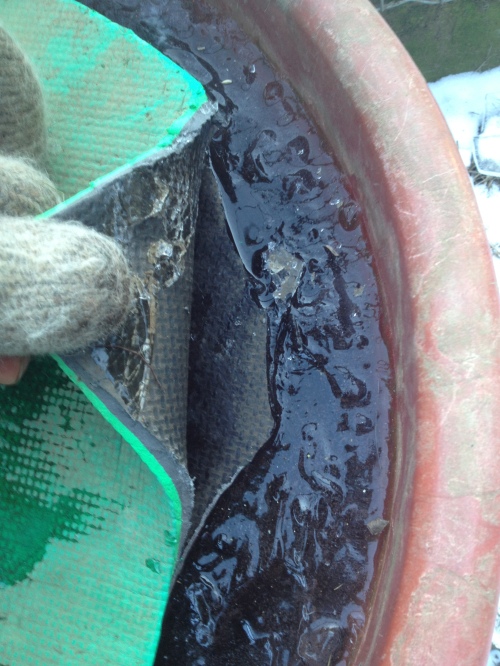During the recent cold snap, I was having my usual problems keeping all the animals watered. There are two main issues to deal with. First, all the water on our long, skinny farm-let originates at the top of the hill at the house. Miles of hoses with various junctions and side shoots and connectors and whatnot distribute water from the tap at the top to animal and poultry pens all the way down to the bottom of the hill. It is not practical to coil up all those hoses and drag them inside each night. Leaving them dripping works as long as the temperature doesn’t dip too low, though it does waste water and results in nasty little ice patches all over the place. The other problem is that the hoses zig and zag, go up and over obstacles and around corners and without fail, those bends and kinks are where ice blocks form, shutting down the system downstream from the blockage.
After I win the lottery (or, maybe I should try one of those crowd funding projects) I will install a frost-free in-ground water system with frost free taps all over the place… But until then, when the hoses freeze I am stuck schlepping hot water in containers from the house.

A five gallon jug of water weighs over 40 lbs. I shudder to think how many pounds I lifted during the past week!
The water needs to be hot because the second problem that develops is the water in the various buckets and tubs freezes. When it isn’t seriously cold, it isn’t hard to smash through the layer of ice on top to get to open water below. When it stays cold for several days or when the temperatures plunge, the layer of ice is too thick to break.
This problem of the top layer freezing was addressed in the current issue of Small Farm Canada (with thanks to regular reader, blogger, and fellow farmer, Sailors Small Farm for pointing this out…). In a short how-to article it was suggested that a piece of closed cell foam insulation cut to fit inside the bucket would keep the water from freezing. The example shown was for a small pail being used by chickens. Holes large enough for the chickens to dip their beaks in had been cut in the foam so the birds could get at the un-frozen water.
As it turned out I had some of this stuff around and thought it might work to stop the goat water container from freezing over.
First I roughly measured the foam – and cut it to size.
I cut a small opening on one side so they could get their muzzles in to drink.
Then, I waited to see what would happen. The goats drank out of the gap just fine and immediately under the foam lid the water did not freeze. But, all around the edges, ice formed the first night. The ice layer grew thicker and it became increasingly difficult to peel off the layer of foam each morning so the goats could get at the ever-smaller water hole in the middle. By the fourth day, the foam was completely frozen into the surface and disintegrated when I tried to peel it back. The opening was the first part to freeze, which wasn’t too surprising…
The opening was the first part to freeze, which wasn’t too surprising… After a few days of being able to peel back the foam, it froze to the surface and came apart when I tried to lift it…
After a few days of being able to peel back the foam, it froze to the surface and came apart when I tried to lift it… It was impossible to remove the last shred of insulation… I went back to the old system of pouring piping hot water into the bucket to thaw a hole and warm up the rest of the water enough that the goats would have a good, long drink.
It was impossible to remove the last shred of insulation… I went back to the old system of pouring piping hot water into the bucket to thaw a hole and warm up the rest of the water enough that the goats would have a good, long drink.
The article suggests that the system is most useful inside a hen house where the temperature is right around freezing but not seriously cold. I’d have to say that when this is the case it really isn’t that big a deal to chip a hole in the skim of ice anyway. Alas, much as I had hoped this would be a great solution to my bucket-freezing problems, it seems I will have to keep looking for other methods and keep experimenting.











Found this:
http://www.homesteadingtoday.com/general-homesteading-forums/homesteading-questions/162314-keeping-water-freezing-w-o-electricity.html
Part way down the page by Isulenes. Would that work? I remember having to deal with frozen water dishes but the house was close to the barn so it wasn’t too bad.
LikeLike
Thanks for the link – the tire stack sounds like a good idea – as does the suggestion one digs a pit and back fills with compost – bucket of water to be placed into the pit… We will keep experimenting!
LikeLike
Filling up the bucket to take out to the chickens, as I type :). Too bad the foam on top thing didn’t work, thanks for the detailed report. That’s a bit of a hazard having bits of foam broken off into the water, huh? Just what you need a goat to suck into their mouth. The tire stack sounds interesting, the homemade version of an insulated water tank.
LikeLike
Son was thrown into a dunk tank recently by his mates. He had both a) completed his first solo flight and b) made it back to the flight room without being discovered. Such a feat was supposed to exempt a pilot student from being subjected to said dunk tank, but the mates apparently hadn’t read the rules.
His training base is in northern Oklahoma, which recently went through a sharp cold snap. There was 2″ of ice on the tank.
They DID remove the ice. And they DID allow him to remove his boots before being dunked. Not much of a surprise, but I bet it was startling, anyway!
LikeLike
Yikes! That would wake a person up in a hurry! Congratulations to your son for surviving both his first solo flight and his frosty dunking!
LikeLike
When I finished writing the comment, I thought, “That didn’t really have much to do with her post, other than frozen water!” So please forgive the non sequitur!
We had fun with frozen water yesterday (also not having anything to do with your post. I’m tired and a little punchy…) We hiked up a steep, narrow ravine. Jagged frames of ice displayed the running water underneath. We had to be really careful with foot and pole placement, but BOY it was FUN!!
LikeLike
Melanie, did you see my question to you in reply to the Belmont Rooster’s comment about the relative speed at which hot and cold water freezes? And, not to worry about the earlier comment – I was totally with you, imagining how awful it would be to take a dip in the horse trough!
LikeLike
No, I didn’t. Link to the post?
HI!! Nice to talk to you in real time! 🙂
LikeLike
Same post, BR commented that hot water freezes more quickly than cold… Which is something I had heard but couldn’t imagine why that would be so…
LikeLike
And, yes – Howdy! This doesn’t happen too often! Probably a good thing or I would likely never leave my computer!
LikeLike
I have been dumping the chickens water at night so it won’t freeze up. It must really be time consuming to have to carry so much water. Just remember, hot water freezes faster than cold water… I have been cutting the ice on the pond for the cattle every morning…
LikeLike
I do the same with the chicken and turkey waters – but can’t with the volume needed for the hogs and horses. On the plus side, the larger volumes of those tanks mean they don’t generally freeze top to bottom, so as long as I can keep everything topped up and holes punched in the surface ice twice a day, everyone seems to do ok. They soon learn to line up for a big drink when it’s available! I had heard that about the hot water freezing faster, but always thought it was an old wives’ tale! Why would that happen? Hey, isn’t Melanie in IA’s husband a physics teacher? Melanie, any thoughts on this?
LikeLike
Yes, Melanie’s husband is a physics teacher, retired. He nods… But here is a link. Apparently under SOME but NOT ALL conditions, this is true.
http://math.ucr.edu/home/baez/physics/General/hot_water.html
LikeLike
Wow – this is absolutely fascinating! Thank you so much for the link! What a great explanation – with a good story to boot! Huh. Who knew?
LikeLike
He is a physics teacher. Actually retired, but once a teacher always a teacher. His blog is so awesome! Melanie’s quilting blog is great, too. Together, they make a great team!
LikeLike
And Jim said you need heaters in your tanks. His family used a little kerosene heater under the hog trough.
LikeLike
I’ve been reading about those… I’d have to make sure the hogs couldn’t get under there – they are monsters when it comes to getting their snouts where they don’t belong, flipping water over, generally making trouble… My next post is actually about that – and how we are dealing with the issue. Perhaps a kerosene heater can be integrated into my new water container design…
LikeLike
I could certainly set something like that up under the horse troughs, which are old bathtubs… Yikes! I have to run – late for a farmerly potluck! Thanks for your suggestions/info!
LikeLike